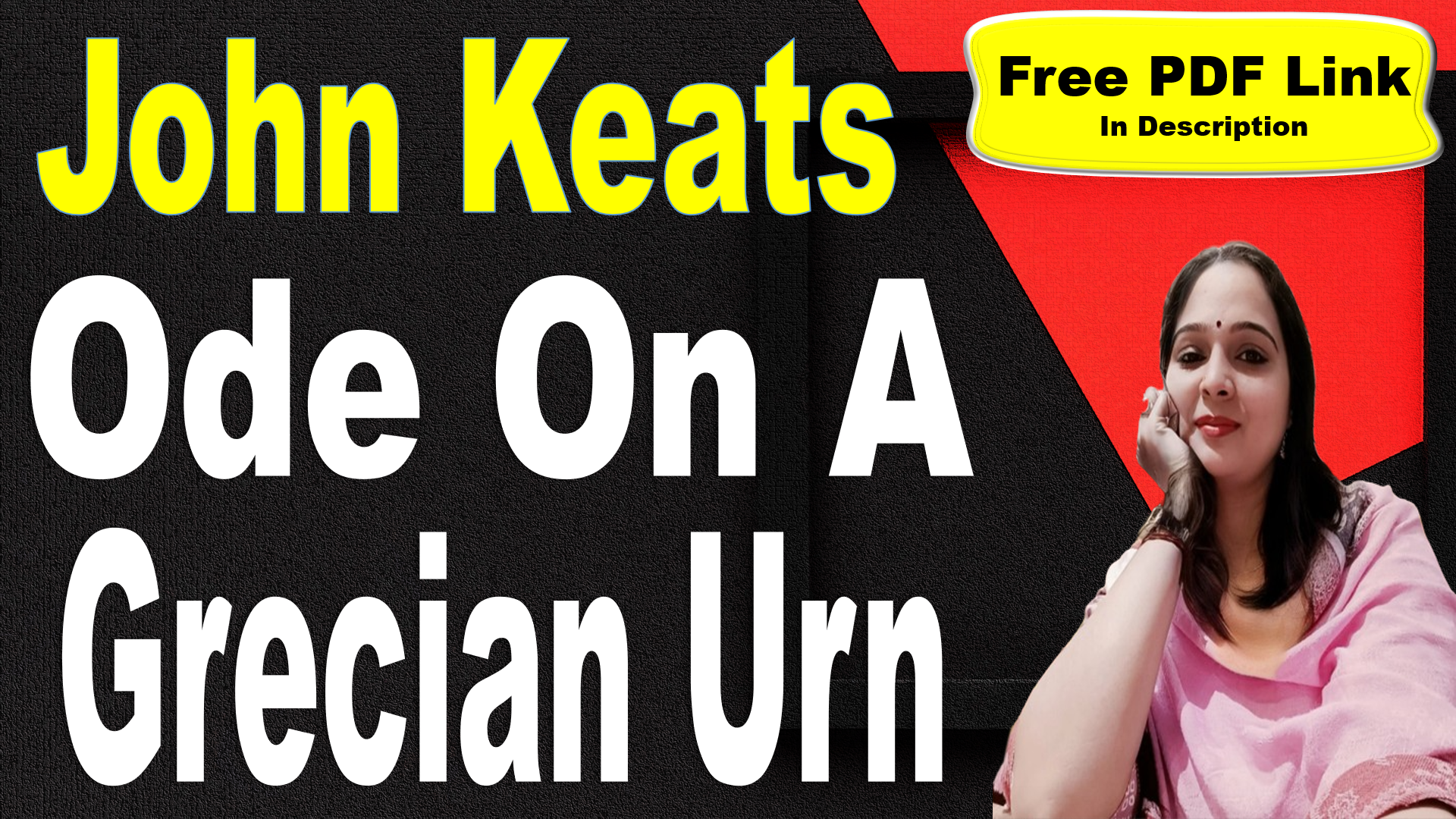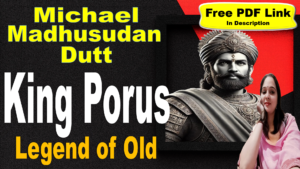Essay Type Questions
Write the critical appreciation of the poem “Ode on a Grecian Urn.”
Introduction
“Ode on a Grecian Urn” is a highly esteemed poem by John Keats, composed in 1819 during what is known as his most creative period. This work serves as a remarkable representation of Romantic literature, encapsulating the movement’s emphasis on emotion, nature, and the pursuit of beauty. In this poem, Keats employs the urn as a symbol to explore themes of art, love, and mortality, establishing a thought-provoking tension between permanence and impermanence.
Central Idea
The central idea in “Ode on a Grecian Urn” centers around the contrast between the timeless beauty captured on the urn and the fleeting nature of human life. Keats explores how art can encapsulate moments of happiness and beauty, preserving them beyond the bounds of time. The poem contemplates the nature of beauty and truth, presenting art as a means of finding solace in an otherwise transient and decaying world.
Structure & Rhyme Scheme
The poem is structured into five stanzas, each comprising ten lines. Keats uses a varied rhyme scheme, beginning with an ABAB pattern in the first four lines and transitioning to a more intricate rhyme in the remaining six lines. This structural form mirrors the rounded and enduring nature of the urn itself, enhancing the reader’s sense of the poem’s formal beauty and reinforcing the significance of art.
Theme
The poem addresses multiple themes, including the tension between eternity and transience, the nature of love, the exploration of beauty, and the inevitability of death. Keats presents art as a medium capable of preserving beauty and conveying eternal truths, which is consistent with Romantic ideals. While human life is characterized by sorrow and fleeting moments, the urn’s scenes remain constant, suggesting a connection between art and a sense of enduring truth.
Style
Keats’s writing style in “Ode on a Grecian Urn” is notable for its rich imagery and reflective tone. He uses a blend of sensuous and philosophical language, which allows readers to appreciate the visual details of the urn while contemplating the larger questions it raises. The contemplative and evocative style highlights Keats’s skill in the ode form, allowing him to explore universal themes through personal emotion.
Poetic Devices
Keats employs several poetic devices to deepen the poem’s emotional impact and thematic resonance:
Alliteration: The repetition of consonant sounds, as in “silence and slow time,” adds rhythm and musicality.
Assonance: The recurrence of similar vowel sounds, such as in “Thou foster child of silence and slow time,” enhances the poem’s musical quality.
Chiasmus: The inverted order in “Beauty is truth, truth beauty” emphasizes their interrelationship and profound connection.
Enjambment: The flow of lines without end punctuation, such as “And, little town, thy streets forevermore / Will silent be,” maintains the continuity of ideas.
Personification: The urn is depicted with human attributes like being an “unravish’d bride” and a “foster child,” which accentuates its beauty and timelessness.
Symbolism: The urn symbolizes eternal art, serving as a counterpoint to the ephemeral nature of human existence.
Rhetorical Questions: Questions like “What men or gods are these?” prompt readers to ponder the meanings of the urn’s scenes.
Repetition: Repeated phrases such as “more happy love” amplify the poem’s emotional tone.
Contrast: The contrast between the eternal beauty of the urn and the fleeting nature of human experiences emphasizes the key themes of the poem.
Critical Commentary
Critics have praised “Ode on a Grecian Urn” for its exploration of the relationship between beauty and human experience. F. R. Leavis admired the poem’s “mature and perfect beauty,” highlighting Keats’s ability to capture the essence of life through art. Similarly, Harold Bloom noted the poem’s portrayal of the paradox of human longing for the unattainable, emphasizing its significance in the Romantic canon. These commentaries affirm the poem’s lasting impact and its ability to evoke deep emotional responses.
Message
The poem conveys a powerful message about the relationship between art, beauty, and human life. Keats suggests that although life is transient and filled with sorrow, art has the power to preserve beauty in an enduring form. The assertion that “Beauty is truth, truth beauty” implies that an understanding of beauty is essential to a meaningful existence, encouraging readers to reflect on the nature of beauty and its connection to deeper truths.
Conclusion
“Ode on a Grecian Urn” stands as a timeless meditation on the enduring power of beauty in the face of mortality. Through the symbol of the urn, Keats explores complex themes of art, love, and existence, ultimately revealing the profound connection between beauty and truth. The poem’s rich imagery, musical quality, and philosophical depth solidify its place as a cornerstone of Romantic poetry, continuing to resonate with readers and critics alike. Keats’s ability to capture the eternal within the transient cements the poem’s status as one of the most significant works in English literature.
Long note on themes used in the poem “Ode on a Grecian Urn”
The poem Ode on a Grecian Urn by John Keats delves into several profound themes, with each providing insight into the poet’s exploration of beauty, time, art, and human experience.
Beauty and Art
A central theme in the poem is the idea of beauty as captured through art. The Grecian urn symbolizes an artistic creation that freezes moments of beauty and emotion for eternity. Keats suggests that art holds the capacity to transcend the limitations of time, preserving human experiences and emotions in a way that feels almost eternal. This concept reflects the Romantic notion that beauty is not merely a transient sensation but rather a profound truth, capable of conveying deep insights into the human condition.
Timelessness vs. Transience
The poem highlights the contrast between the eternal and the transient. The urn’s depictions remain unchanged and untouched by time, portraying scenes of joy, love, and ritual in a state of permanence. In contrast, real-life experiences are subject to the passage of time, decay, and death. This tension between the permanence of art and the fleeting nature of life reveals Keats’s contemplation on the human desire for immortality in a world defined by constant change.
The Relationship Between Art and Reality
Keats uses the urn to explore the distinction between art and reality. The images on the urn are still and perfect, presenting an idealized vision of life that is free from the sorrow and imperfections of reality. Yet, their static nature also underscores a limitation of art—it cannot capture the full complexity or dynamic nature of human experiences. Keats seems to suggest that while art can provide a semblance of immortality and idealism, it remains a representation, not a replacement, of reality.
Imagination vs. Reality
Throughout the poem, Keats alludes to the idea that the imagined or idealized forms of life and beauty are often more appealing or meaningful than their real-world counterparts. In the famous lines describing the “unheard melodies” as sweeter than those actually heard, Keats emphasizes the power of the imagination to elevate and perfect experiences beyond the physical realm. This exploration underscores the Romantic notion that imagination transcends reality and offers a heightened perception of beauty.
Love and Desire
The poem’s depiction of lovers on the urn serves as an exploration of love and desire. The lover is portrayed in a perpetual state of yearning, forever close to achieving his desire but never reaching it. This depiction evokes the bittersweet nature of longing and emphasizes the paradox of eternal anticipation without fulfillment. In preserving love in its idealized, yet incomplete state, the urn becomes a symbol of both the beauty and the limitations inherent in human desire.
Truth and Knowledge
Keats’s famous assertion, “Beauty is truth, truth beauty,” encapsulates a significant theme of the poem: the relationship between aesthetics and understanding. The poet proposes that the appreciation of beauty is, in itself, a form of truth or knowledge. This idea aligns with the Romantic belief in the unity of beauty, emotion, and understanding, suggesting that through art and beauty, one can gain deeper insights into life’s complexities.
Sacrifice and Ritual
In the poem’s fourth stanza, Keats describes a ritualistic scene where a priest leads a heifer to an altar. This scene connects the themes of art, devotion, and spirituality, hinting at the ways in which human life is intertwined with the cycles of nature and communal rituals. By evoking a sacrificial moment, Keats encourages readers to contemplate the role of ritual in human culture and its relation to the permanence and passage of time.
Each of these themes interweaves to create a rich tapestry of ideas, encouraging reflection on the nature of beauty, art, and the human condition. Keats’s ode serves not only as a meditation on the Grecian urn itself but also as a broader philosophical exploration of life, art, and eternity.










